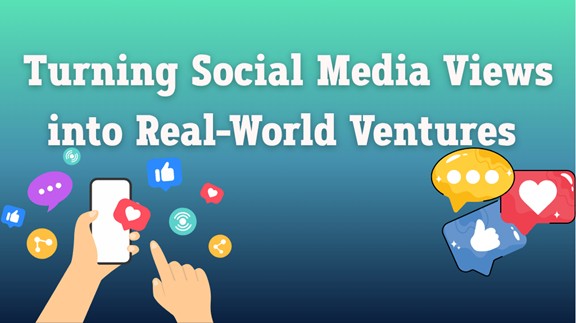Turning Social Media Views into Real-World Ventures

The traditional career path is no longer the only route to a successful livelihood. A new generation of entrepreneurs is emerging not from business schools but from bedrooms, home studios, and city streets, armed with little more than a smartphone and an idea. This is the new creator economy, a digital landscape where content is currency and influence is a tangible asset. It’s a fundamental shift in how we think about work, branding, and value creation.
But how does a passion project cross the chasm into a profitable enterprise? It starts by looking beyond the surface and understanding that in this economy, not all views are created equal.
Beyond the Follower Count: The Real Metrics of a Creator Business
For years, the ultimate badge of honor for an online personality was a massive follower count. While a large audience is still important, savvy creators and the brands that partner with them now look at deeper, more meaningful metrics. Think of it as the difference between a crowded room and an engaged audience. A million followers who never interact are far less valuable than ten thousand who actively comment, share, and champion your content.
Engagement rate, watch time, and click-through rates are the new gold standard. Why? Because these figures tell a story. They show that an audience isn’t just passively scrolling; they are invested. A high watch time on a YouTube video signals to the algorithm that the content is compelling, leading to wider promotion. A flurry of shares on a TikTok post creates a viral loop that organically expands reach. This level of engagement is the true foundation upon which a creator can build a sustainable business.
The journey from content creator to business owner is paved with strategic decisions. Once you understand what drives engagement, the next logical step is monetization.
The Monetization Ladder: From First Earnings to a Full-Fledged Brand
Monetization in the creator economy isn’t a single event; it’s a multi-stage process, often referred to as the “monetization ladder.” Each rung represents a different way to convert audience attention into revenue.
The first step for many is platform-native monetization. This includes things like the YouTube Partner Program, which shares ad revenue, or TikTok’s Creator Fund. While these are excellent starting points, they are often reliant on massive view counts and can be unpredictable.
The next rung involves direct partnerships, and this is where affiliate marketing and brand sponsorships come into play. A creator with a dedicated niche audience, even a small one, can be incredibly valuable to a company whose products align with that audience. A positive review or a simple product placement can drive significant sales, creating a win-win scenario.
At the top of the ladder are direct-to-consumer ventures. This is where the creator transitions fully into an entrepreneur. They leverage their brand and audience trust to sell their own products, be they merchandise, digital courses, coaching services, or physical goods. This model offers the highest profit margins and the most control, effectively turning a personal brand into a diversified company. Earning money is one thing; building a sustainable business is another. This is where many creators stumble, failing to see their channel as more than just a hobby.
Building the Business Infrastructure
The most successful creators treat their online presence as a startup. They have a content strategy, a marketing plan, and a clear understanding of their brand identity. This entrepreneurial mindset is what separates fleeting viral stars from long-term media moguls. A crucial early tool in this process is a professional media kit, a document that outlines your channel’s statistics, audience demographics, and collaboration rates, making it easy for potential partners to see your value.
For many creators just starting out, gaining initial traction is the biggest hurdle. Reports suggest that channels with an established baseline of engagement have faster growth in their first year, as algorithms begin to favor their content. Using trusted growth platforms like Views4You can help accelerate that process, providing the engagement boost needed to attract visibility and build early audience trust. Effectively implementing social media growth strategies can provide that crucial early momentum, turning a channel from invisible to influential.
Furthermore, diversifying income is key to long-term stability. Relying on a single platform or a single brand deal is a risky proposition. The smartest creators build revenue streams across multiple platforms and through various models, ensuring that if one source dries up, the entire business doesn’t collapse. They are not just YouTubers or Instagrammers; they are CEOs of their own media enterprises.
From Influence to Impact: Building Purpose-Driven Ventures
The final evolution of a creator business is not just profitability: it’s purpose. As audiences become more discerning, they seek creators who stand for something beyond sales and sponsorships. The future belongs to those who turn influence into impact.
Purpose-driven creators use their platforms to address real-world issues, from sustainability and mental health to diversity and education, aligning their personal brands with values that resonate deeply with their communities. This alignment not only fosters stronger loyalty but also attracts brands seeking authentic partnerships that go beyond traditional advertising.
By integrating a mission into their business model, creators unlock opportunities that transcend digital fame. Whether launching eco-conscious product lines, funding charitable causes, or mentoring new creators, these entrepreneurs redefine what success looks like in the creator economy. In a world where attention is currency, meaning is the ultimate investment.
Frequently Asked Questions
How much money can a small creator realistically make?
Income varies wildly, but it’s not uncommon for creators with a few thousand highly engaged followers in a profitable niche (like finance or tech) to earn a few hundred to a couple of thousand pounds per month through a mix of affiliate sales and small brand deals.
Do you need expensive equipment to start a creator venture?
Absolutely not. Today’s smartphones have high-quality cameras and microphones that are more than sufficient for creating professional-looking content. Good lighting and clear audio are more important than expensive gear.
What’s the biggest mistake new creators make when trying to monetize?
The most common mistake is trying to monetize too early or in a way that feels inauthentic to their audience. Promoting a product you’ve never used or don’t believe in can quickly erode trust.
How long does it typically take to see significant income from content creation?
There is no set timeline, but creators should be prepared for the long haul. It often takes 6-12 months of consistent content creation to build a meaningful audience and another 6-12 months to translate that into a reliable income stream.


